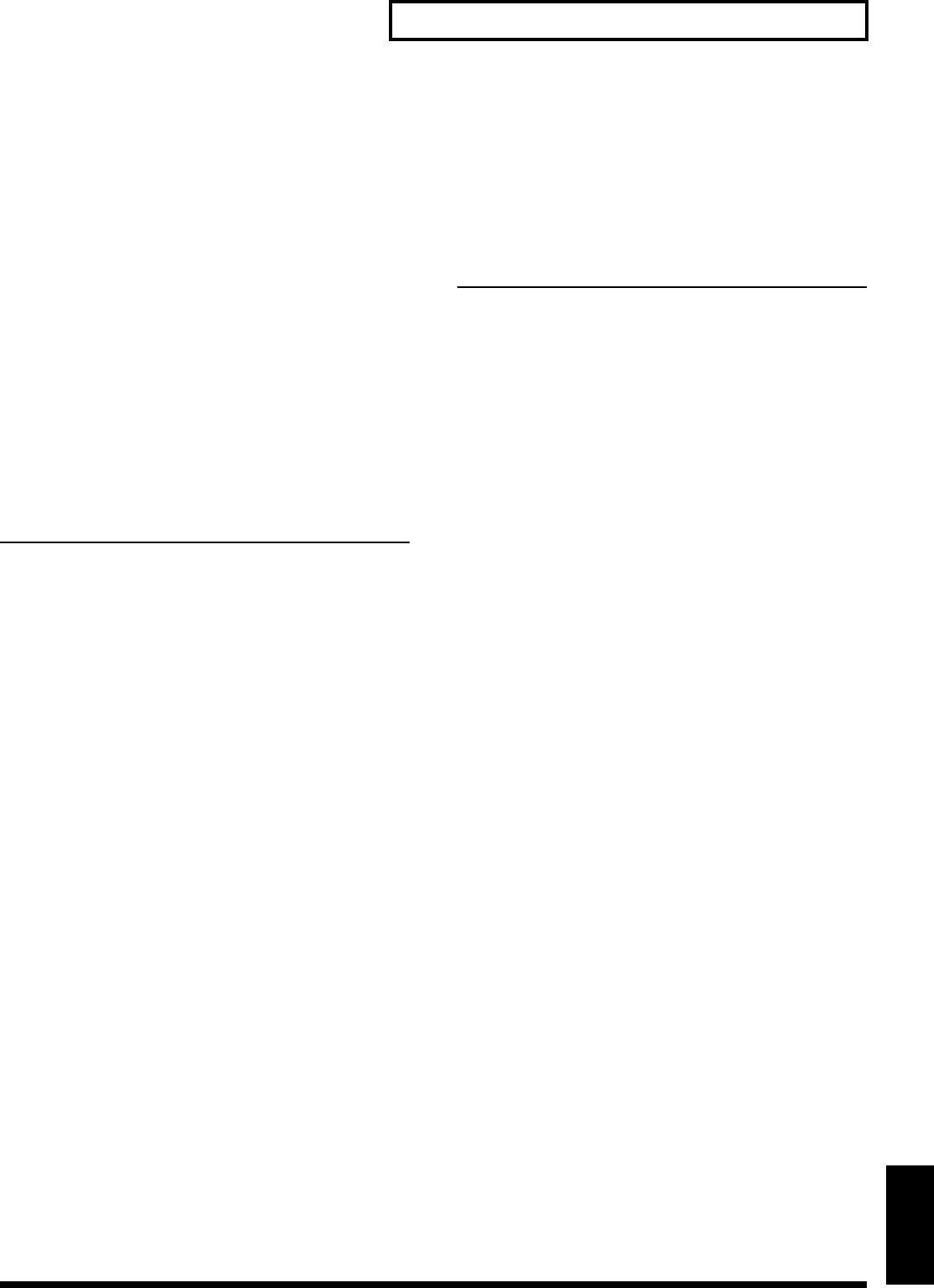
117
Effect/Parameter List
Appendices
Manual #
Sets the point at which the two vowels will be switched. When
set to 50, Vowels 1 and 2 switched in the same amount of time.
Setting this higher than 50 increases the time for Vowel 1;
setting this lower than 50 decreases the time for Vowel 1.
Low Gain
Specifies the low frequency gain (amount of boost or cut).
Positive (+) settings will emphasize (boost) the low frequency
range.
High Gain
Specifies the high frequency gain (amount of boost or cut).
Positive (+) settings will emphasize (boost) the high frequency
range.
Pan (Output Pan)
Specifies the stereo location of the output sound. L64 is far left, 0
is center, and 63R is far right.
Level (Output Level)
Specifies the output volume.
44: RING MODULAT (Ring Modulator)
Ring Modulator is an effect which applies amplitude
modulation (AM) to the input signal, producing bell-like
sounds.
You can also change the modulation frequency according to the
volume of the sound input to the effects device.
Frequency #
Sets the frequency at which modulation will be applied.
Modulate (Modulator)
Selects the input of the direct sound for the envelope controlling
the modulation.
When set to SOURCE, the frequency is modulated according to
the envelope of the sound input to the multi-effects.
When set to DIRECT, the frequency is modulated according to
the sound as it is without passing through the effects.
Mod_Mon (Modulator Monitor)
Determines whether the input sound used as the modulator is
output (ON) or not (OFF).
Sens (Sensitivity) #
Sets the amount of frequency modulation applied.
Polarity
Determines whether the frequency modulation moves towards
higher frequencies (UP) or lower frequencies (DOWN).
Low Gain
Adjust the low frequency gain (amount of boost or cut). Positive
(+) settings will emphasize (boost) the low frequency range.
High Gain
Adjust the high frequency gain (amount of boost or cut).
Positive (+) settings will emphasize (boost) the high frequency
range.
Balance (Effect Balance) #
Sets the volume balance between the direct sound and the effect
sound.
With a setting of D100:0W only the direct sound will be output,
and with a setting of D0:100W the effect sound will be output.
Level (Output Level)
Adjust the output level.
45: MULTI TAP DLY (Multi Tap Delay)
The Multi Tap Delay has four delays. Each of the Delay Time
parameters can be specified as a note length of the selected
tempo. You can also set the panning and level of each delay
sound.
Delay 1 (Delay Time 1)
Adjust the delay time from the direct sound until the delay 1
sound is heard.
Delay 2 (Delay Time 2)
Adjust the delay time from the direct sound until the delay 2
sound is heard.
Delay 3 (Delay Time 3)
Adjust the delay time from the direct sound until the delay 3
sound is heard.
Delay 4 (Delay Time 4)
Adjust the delay time from the direct sound until the delay 4
sound is heard.
➔
Delay 1–4 parameters can be set as a note-value of a tempo. In
this case, specify the value of the desired note.
Pan 1 (Output Pan 1)
Sets the stereo position of the delay sound (Delay 1). A setting
of L64 is far left, 0 is center, and 63R is far right.
Pan 2 (Output Pan 2)
Sets the stereo position of the delay sound (Delay 2). A setting
of L64 is far left, 0 is center, and 63R is far right.
Pan 3 (Output Pan 3)
Sets the stereo position of the delay sound (Delay 3). A setting
of L64 is far left, 0 is center, and 63R is far right.
Pan 4 (Output Pan 4)
Sets the stereo position of the delay sound (Delay 4). A setting
of L64 is far left, 0 is center, and 63R is far right.
Level 1
Adjust the output level of delay 1.
Level 2
Adjust the output level of delay 2.
Level 3
Adjust the output level of delay 3.
Level 4
Adjust the output level of delay 4.
Feedback #
Adjust the proportion (%) of the delay sound that is to be
returned to the input. Positive (+) settings will return the signal
to the input with the original phase, while negative (-) settings
produce an inverted phase.
RD-700_e.book 117 ページ 2004年4月26日 月曜日 午前11時54分


















